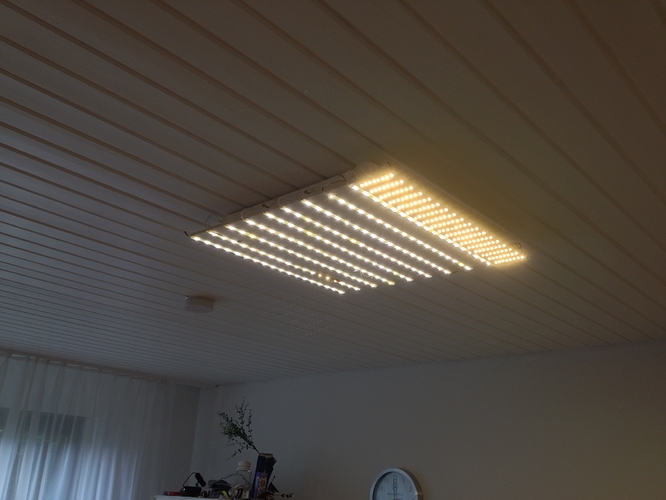First of all, I really love Blynk. Makes everything so easy 
I’ve made a “little” ceiling lamp with Blynk, Particle Photon, 13m White LED Strip, 2x MOSFET’s and WS2812 LED’s although It isn’t completely finished ( had no 5V 4A power supply laying around ) I wanted to share this with you. 
The main part consist of a 0,6m x 0,6m wooden panel where also the LED stripes are mounted.
If you have any suggestions what I also could add please tell me 
Code:
#include "neopixel/neopixel.h"
#include "blynk/blynk.h"
#define PIXEL_PIN D3
#define PIXEL_COUNT 64
#define PIXEL_TYPE WS2812B
Adafruit_NeoPixel strip = Adafruit_NeoPixel(PIXEL_COUNT, PIXEL_PIN, PIXEL_TYPE);
char auth[] = "Haha nice try";
void setup()
{
Serial.begin(9600);
delay(5000);
Blynk.begin(auth);
pinMode(0, OUTPUT);
pinMode(1, OUTPUT);
analogWrite(0, 255);
analogWrite(1, 255);
strip.begin();
strip.show();
}
void loop()
{
Blynk.run();
if (ModeBtnPressed()) {
Blynk.notify("Mode button was pressed");
}
}
BLYNK_WRITE(V0) {
analogWrite(0, param.asInt());
}
BLYNK_WRITE(V1)
{
analogWrite(1, param.asInt());
}
// Attach a ZeRGBa widget (mode: Merge) to the Virtual pin 21
BLYNK_WRITE(V21) {
int r = param[0].asInt();
int g = param[1].asInt();
int b = param[2].asInt();
if (r > 0 && g > 0 && b > 0) {
strip.setPixelColor(29, r, g, b);
} else {
}
}
// Some example procedures showing how to display to the pixels:
// Do not run more than 15 seconds of these, or the b/g tasks
// will be blocked.
//--------------------------------------------------------------
//strip.setPixelColor(0, strip.Color(255, 0, 255));
//strip.show();
//colorWipe(strip.Color(255, 0, 0), 50); // Red
//colorWipe(strip.Color(0, 255, 0), 50); // Green
//colorWipe(strip.Color(0, 0, 255), 50); // Blue
//rainbow(20);
//rainbowCycle(20);
//colorAll(strip.Color(0, 255, 255), 50); // Cyan
void colorAll(uint32_t c, uint8_t wait) {
uint16_t i;
for(i=0; i<strip.numPixels(); i++) {
strip.setPixelColor(i, c);
}
strip.show();
delay(wait);
}
bool ModeBtnPressed() {
if(millis() > 5000) {
if(BUTTON_GetDebouncedTime(BUTTON1) >= 50) {
BUTTON_ResetDebouncedState(BUTTON1);
return 1;
}
}
return 0;
}`


